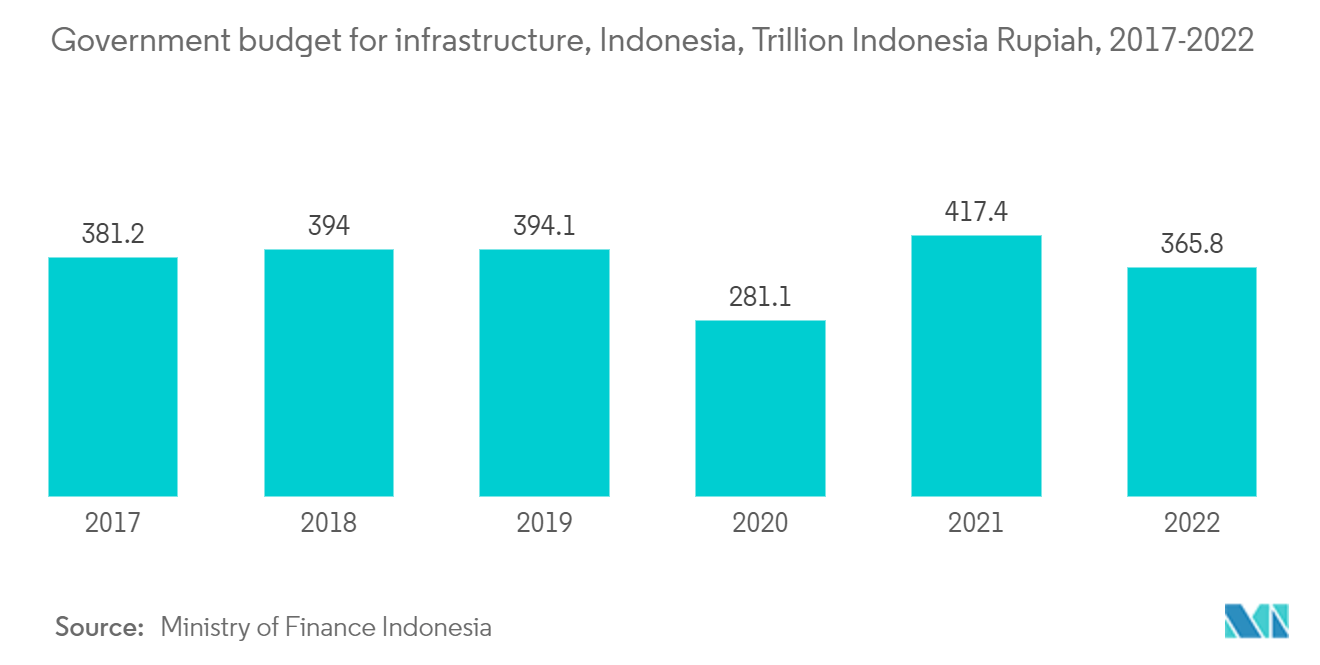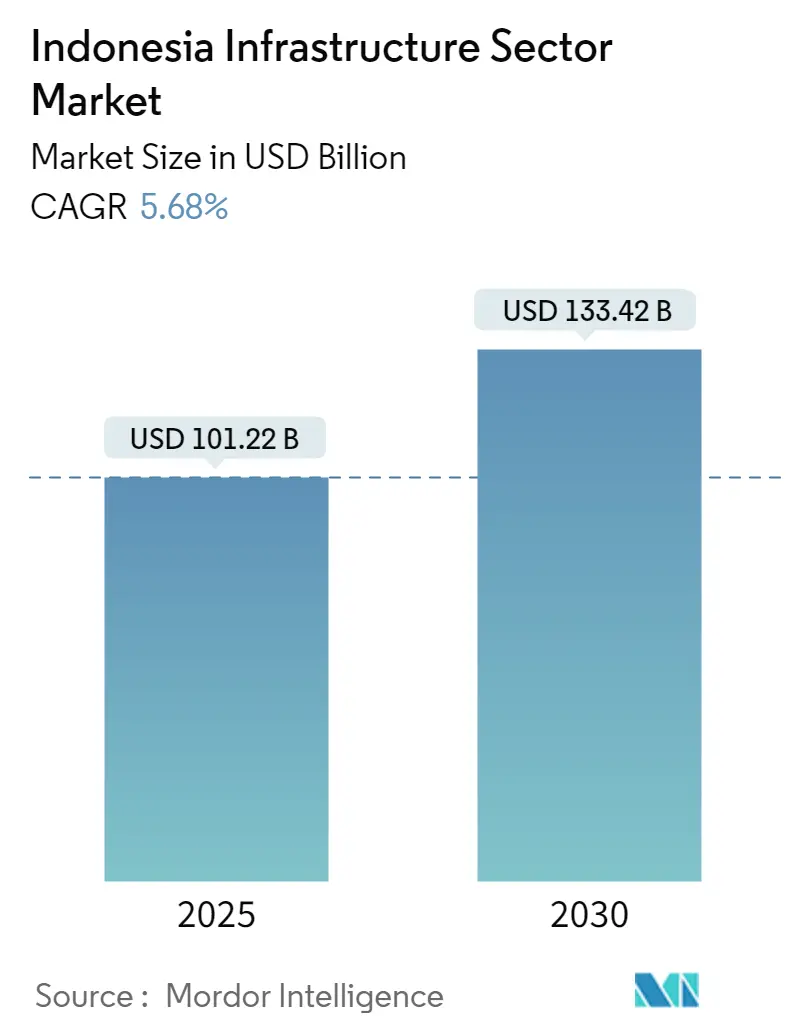
| Study Period | 2020 - 2030 |
| Base Year For Estimation | 2024 |
| Forecast Data Period | 2025 - 2030 |
| Market Size (2025) | USD 101.22 Billion |
| Market Size (2030) | USD 133.42 Billion |
| CAGR (2025 - 2030) | 5.68 % |
| Market Concentration | Medium |
Major Players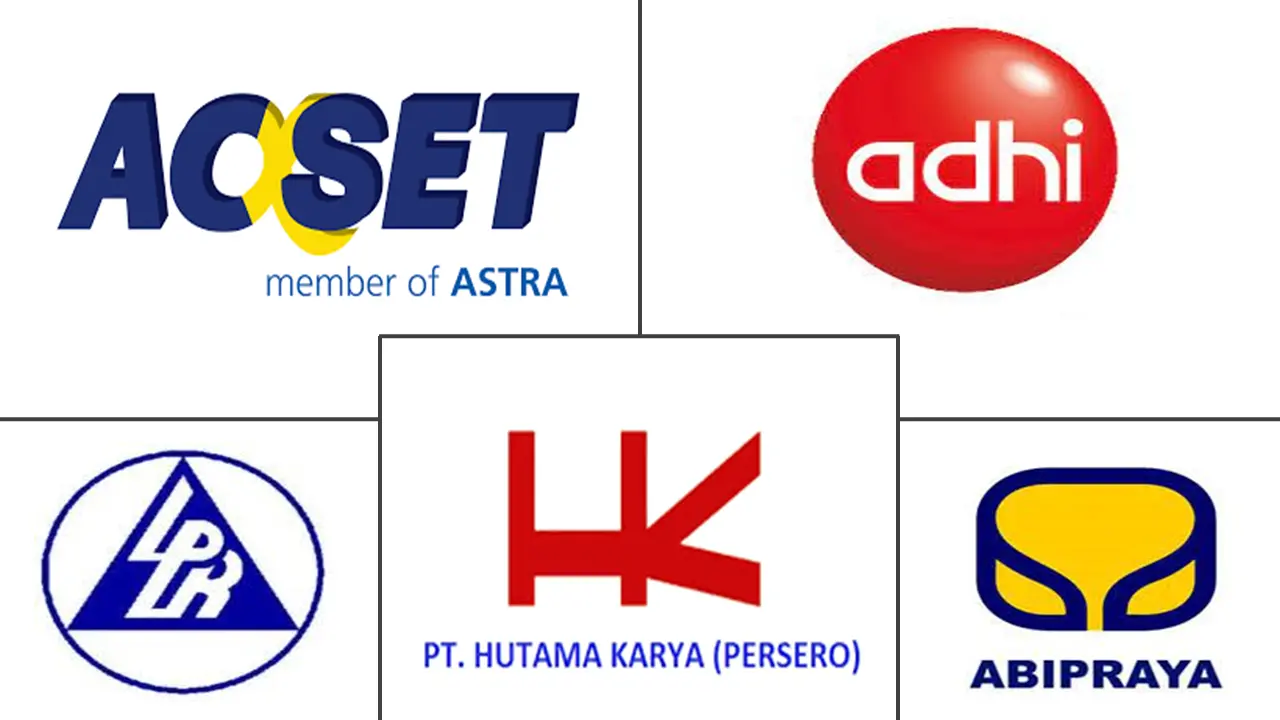
*Disclaimer: Major Players sorted in no particular order |
Indonesia Infrastructure Market Analysis
The Indonesia Infrastructure Sector Market size is estimated at USD 101.22 billion in 2025, and is expected to reach USD 133.42 billion by 2030, at a CAGR of 5.68% during the forecast period (2025-2030).
- Indonesia's government increased its infrastructure investments by USD 429.7 billion in 2020-2024, up 20% from USD 359.2 billion in 2015-2019. After a decline brought on by the COVID-19 crisis, aggregate production in Indonesia significantly increased in 2021. The Indonesian government has initiated a program to upgrade basic infrastructure, including roads, airports, and seaports, which will likely stimulate demand for building materials. Infrastructure development was given IDR 414 trillion (USD 28.5 billion) in the country's 2021 state budget, a 47% increase from the 2020 budget.
- According to the spokesperson of Volvo Construction Equipment, several ongoing significant projects are boosting the demand for aggregates and quarrying equipment in the nation.
- Infrastructure financing through the country's Government and Private Cooperation Scheme reached 83 projects with a total investment of USD 40 billion. About 30 projects totaling USD 50 billion were generated for the non-government budget expenditure financing scheme.
- In 2021, the PUPR Ministry continued its priority and strategic initiatives to improve national priority achievements, including infrastructure, balanced regional growth, and the sustainability of food, energy, and living climate in the infrastructure sector. These national priorities are implemented through water resource management by improving quantity, quality, and water accessibility, covered by ongoing dam constructions (49 dams).
- The large population and robust domestic demand in Indonesia are anticipated to result in favorable economic growth in the Indonesian infrastructure sector. With 250 million people, more than half of whom reside in cities, Indonesia has a sizable domestic market. Additionally, an expanding and wealthy middle class promotes GDP growth, with about 60% of GDP coming from private consumption.
Indonesia Infrastructure Market Trends
Increase in Value of Civil Construction
- The building industry is the fourth-largest contributor to Indonesia's GDP. Among all Asian countries, Indonesia has some of the highest levels of construction investment. The government's goal of building the archipelago's infrastructure to improve connection has helped the business thrive.Java Island, Indonesia's most populous island and the location of its capital city, Jakarta, has been the center of the country's infrastructural development over the past several decades.
- Despite the expansion of neighboring islands, the total value of its completed development projects is still more than 40 times greater than that of Bali and 30 times greater than that of Papua. The Indonesian government has been constructing toll roads nationwide to lessen development disparities. The Trans-Sumatra Toll Road, Indonesia's greatest infrastructure project, connects the northern and southern halves of Sumatra, the second-largest island in the archipelago and the sixth-largest island in the world.
- Over 80% of Indonesia's construction businesses are small businesses that depend primarily on local labor. The majority of Indonesia's construction employees are located in West Java. Finding a permanent construction job in Indonesia is still uncommon because most workers are contracted day laborers who lack credentials and formal education. The Indonesian government has assisted these workers in getting the formal certification required to advance their careers in recent years.
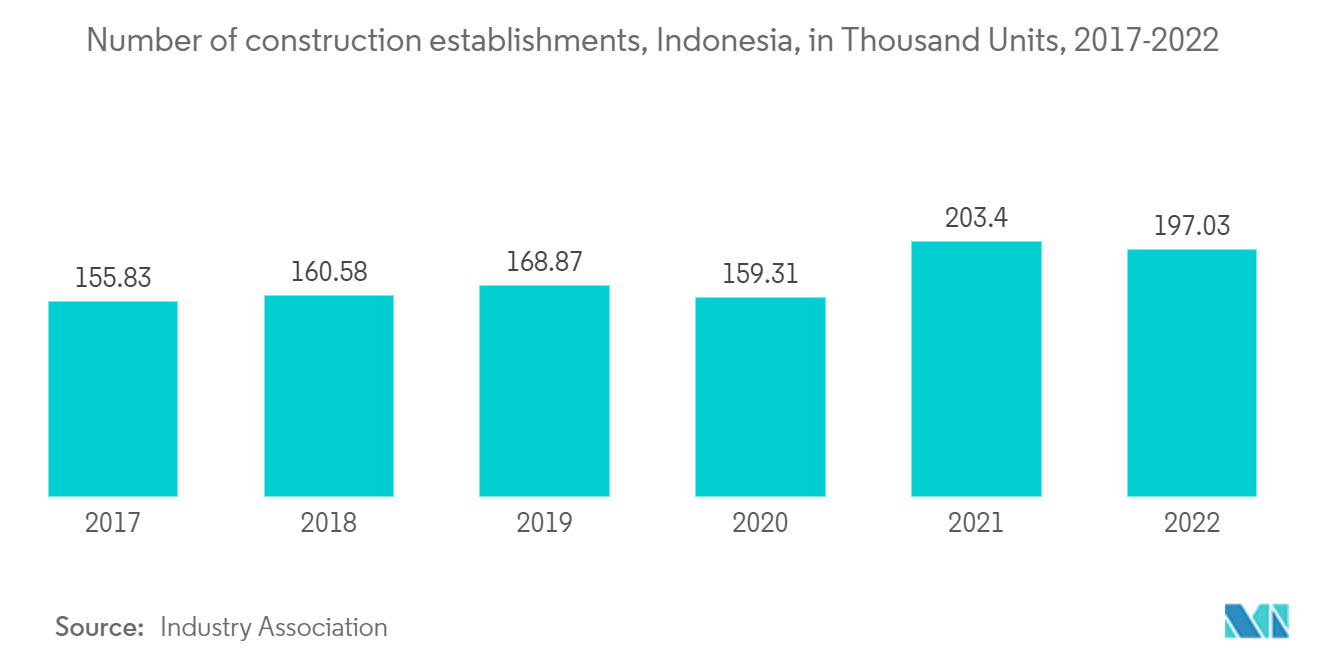
Government's Infrastructural Development Plans
- Increased geographical diversity is likely an emerging trend in developing infrastructure in Indonesia. Although construction activity in recent years has been concentrated in Jakarta and the surrounding provinces of Banten and West Java, the Jokowi administration aims to decentralize business activity away from Java. Many projects were proposed in the latest round of talks with Beijing in Jakarta, including four hydropower plants in North Kalimantan and coal-fired power plants, industrial parks, ports, and other facilities in Central Kalimantan, North Sumatra, North Sulawesi, and on the Bali resort island.
- The Indonesian government has charged its state-owned business Pelindo II with creating and running an expansion of the current Tanjung Priok harbor in North Jakarta, Indonesia's main commercial port, to improve the quality and quantity of its infrastructure. This new port, which will operate as a port of the highest caliber, will be named New Priok Port or Kalibaru Port. The project began in 2012 and is estimated to be completed by the end of the current year. The Indonesian government allotted around IDR 365.8 trillion (USD 26.5 billion) for infrastructure in 2022, a decline of more than IDR 50 trillion (USD 0.32 billion). The total cost of finished civil construction in Indonesia was IDR 752.7 trillion (USD 90.89 billion) 2020.
Indonesia Infrastructure Industry Overview
The Indonesia Infrastructure Sector Market is fragmented with many regional and local players and is expected to grow during the forecast period due to the country's rapid growth in infrastructure projects. Some of the major players in the market are PT. Acset Indonusa TBK, PT. Adhi Karya (Persero) TBK, PT. Brantas Abipraya (Persero), PT. Hutama Karya (Persero), PT. Indonesia Pondasi Raya TBK, and many more. The Indonesian government has accelerated public infrastructure development in the last eight times. Several sectors, similar to transport and energy, are prioritized to encourage profitable investment growth. The government cooperates with business realities( using PPPs) in these strategic systems, attracting public and foreign private investments.
Indonesia Infrastructure Market Leaders
-
PT. Acset Indonusa TBK
-
PT. Adhi Karya (Persero) TBK
-
PT. Brantas Abipraya (Persero)
-
PT. Hutama Karya (Persero)
-
PT. Indonesia Pondasi Raya TBK
- *Disclaimer: Major Players sorted in no particular order
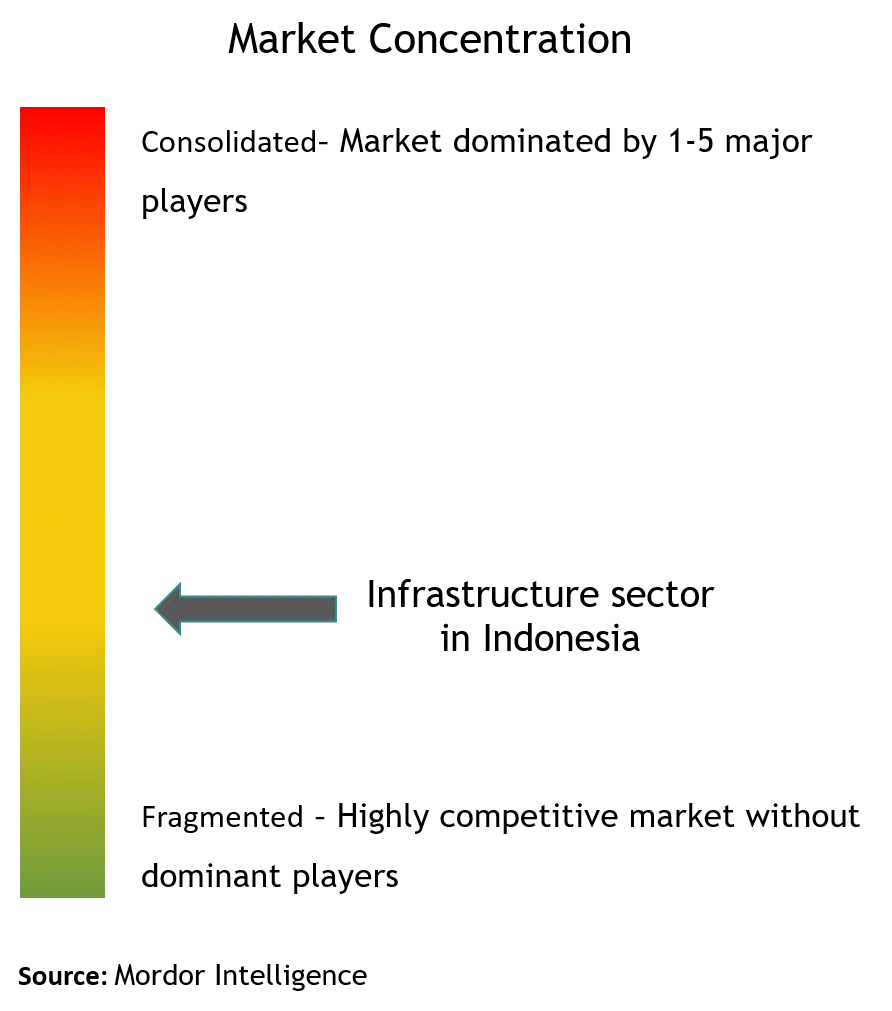
Indonesia Infrastructure Market News
- December 2022: The Japan Bank for International Cooperation (JBIC) signed a memorandum of understanding (MOU) with PT Pupuk Indonesia (Persero). The objectives of the MOU include promoting cooperation in sectors that use hydrogen and ammonia as fuel sources. JBIC aims to accelerate the structuring of projects for developing the supply chain of hydrogen and ammonia as a fuel source. The signing of the MOU will also promote multiple initiatives, including the Asia Zero Emissions Community (AZEC) Concept, through, for example, securing the production bases and supply chain of hydrogen and ammonia.
- April 2023: Reservoir Link Energy Bhd has entered into an agreement with PT Unilever Oleo Chemical Indonesia (PTUOI) for the right to undertake construction, commissioning, and operations of a new wastewater treatment plant in PTUOI’s premises located in Sei Mangkei, North Sumatra, Indonesia. The tenure for the agreement will be for ten years, starting from the date of commercial operations.
Indonesia Infrastructure Industry Segmentation
Infrastructure is the backbone of domestic and international commerce and industrial and agricultural production. It is the fundamental organizational and physical framework necessary to operate a firm successfully. Basic infrastructure in an organization or a nation comprises communication and transportation, sewage, water, a health and education system, safe drinking water, and a monetary system. A complete background analysis of the United Kingdom EV Charging Infrastructure Market, including the assessment of the economy and contribution of sectors in the economy, a market overview, market size estimation for key segments, emerging trends in the market segments, market dynamics, and geographical trends, and COVID-19 impact, is covered in the report.
The Infrastructure Sector in Indonesia is Segmented by the Infrastructure Segment (Social Infrastructure, Transportation Infrastructure, Extraction Infrastructure, Utilities Infrastructure and Manufacturing Infrastructure). The Market Size and Forecast Values (USD) for all the Above Segments.
| By Infrastructure Segment | Social Infrastructure |
| Transportation Infrastructure | |
| Extraction Infrastructure | |
| Manufacturing Infrastructure | |
| Utilities Infrastructure |
Indonesia Infrastructure Market Research FAQs
How big is the Indonesia Infrastructure Sector Market?
The Indonesia Infrastructure Sector Market size is expected to reach USD 101.22 billion in 2025 and grow at a CAGR of 5.68% to reach USD 133.42 billion by 2030.
What is the current Indonesia Infrastructure Sector Market size?
In 2025, the Indonesia Infrastructure Sector Market size is expected to reach USD 101.22 billion.
Who are the key players in Indonesia Infrastructure Sector Market?
PT. Acset Indonusa TBK, PT. Adhi Karya (Persero) TBK, PT. Brantas Abipraya (Persero), PT. Hutama Karya (Persero) and PT. Indonesia Pondasi Raya TBK are the major companies operating in the Indonesia Infrastructure Sector Market.
What years does this Indonesia Infrastructure Sector Market cover, and what was the market size in 2024?
In 2024, the Indonesia Infrastructure Sector Market size was estimated at USD 95.47 billion. The report covers the Indonesia Infrastructure Sector Market historical market size for years: 2020, 2021, 2022, 2023 and 2024. The report also forecasts the Indonesia Infrastructure Sector Market size for years: 2025, 2026, 2027, 2028, 2029 and 2030.
Our Best Selling Reports
Indonesia Infrastructure Industry Report
The Indonesia infrastructure market is experiencing significant growth across various segments, including social, transportation, extraction, and manufacturing infrastructures, crucial for supporting the burgeoning Indonesia garment and textile industries. Investments in schools and hospitals within the social infrastructure segment are projected to see considerable growth, reflecting the country's focus on economic development. The transportation segment, fueled by technological advancements and increased investments in roads and railways, is expected to hold a major market share, supporting the need for efficient infrastructure to accommodate urbanization and improve connectivity across the archipelago. This is vital for the fashion industry in Indonesia, ensuring smooth operations for Indonesia textile companies. Additionally, the extraction and manufacturing sectors are critical, with investments enhancing Indonesia's capabilities in natural resources and industrial production, directly benefiting the textile industry. This comprehensive development supports Indonesia's growing urban population and expanding economic activities, making the infrastructure sector pivotal to the national economic strategy and the success of the Indonesia garment industry.
The market overview highlights the market segmentation across different infrastructure sectors, emphasizing the market value and market growth. The industry analysis reveals the industry trends and market predictions, showing a positive industry outlook. The market forecast and market data indicate a robust growth rate, driven by significant market leaders in the sector. The industry information and industry statistics provided in the industry reports and market report offer valuable insights into the market size and market share. The market research and industry research conducted by research companies further elaborate on the market analysis and market review. The report example and report pdf available for download provide detailed industry sales and industry size information, essential for understanding the market dynamics and market outlook.



